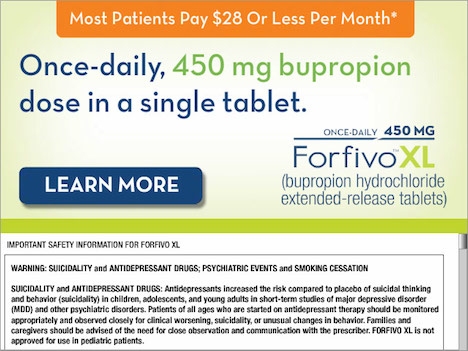
 |
|
 |
|
|
Advertisement 
Advertisement 
|
September 3, 2014
When Do Depression Medications Help Enough?
Nashville—Antidepressant medication by itself is not enough to effectively treat patients with severe, nonchronic depression, according to a new study.
Here’s an Answer The research, published recently in JAMA Psychiatry, suggests that those patients have better rates of recovery if they are treated with cognitive therapy (CT) combined with antidepressant medication (ADM). Background in the article notes “a growing consensus that reducing depressive symptoms isn’t enough and that a return to full normalization should be the goal.” The authors, led by researchers from Vanderbilt University in Nashville, add that medication is the most common treatment for depression, especially when the condition is more severe. For the randomized clinical trial, the researchers involved 452 adult outpatients with chronic or recurrent major depressive disorder (MDD) at three university medical centers in Philadelphia, Chicago and Nashville. With 225 patients treated with ADM alone, another 227 received combined treatment of CT and ADM over 42 months until recovery was achieved. Remission was defined as 4 consecutive weeks of minimal symptoms, while recovery was defined as another 26 consecutive weeks without relapse. Results indicate that combined treatment of CT plus ADM improved rates of recovery compared to ADMs alone, 72.6% versus 62.5%. The severity and chronic nature of the conditions had a significant effect, however. Study authors report that the advantage for combined treatment was limited to the 146 patients with severe, nonchronic depression, 81.3% versus 51.7%. For patients with less severe major depressive disorder (MDD) or chronic MDD, recovery rates were similar across the groups. While patients who underwent combined treatment also reported fewer serious adverse events than patients treated with ADMs alone, this was largely due to less time spent in an MDD episode, according to the report. “Our findings suggest that CT engages different mechanisms than ADM but that it likely does so only in some patients,” the authors conclude. “Identifying these mechanisms may suggest ways to enhance treatment response. Future combinatorial trials should include comparisons with CT alone to examine the viability of each monotherapy, especially given evidence that CT effects persist beyond the end of treatment.” In a related editorial, Michael E. Thase, MD, of the University of Pennsylvania in Philadelphia, suggests, “The study is important because of the topic—MDD is one of the world’s great public health problems and the combination of psychotherapy and pharmacotherapy has long been advocated as a preferred approach to optimize outcomes—and the approach taken, a large-scale (n=452), three-center study with adequate power to test both main effects and possible interactions across both short-term and continuation phases of study treatment.” “The main findings are largely supportive of the value of combined treatment for MDD: patients receiving CT in addition to pharmacotherapy were significantly more likely to recover than were the patients who received pharmacotherapy alone,” Thase notes. |
U.S. Pharmacist Social Connect

 |
|

